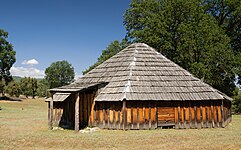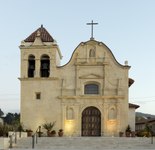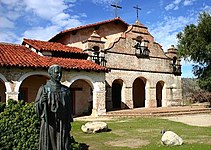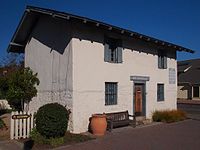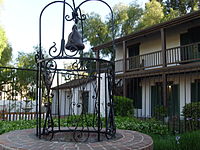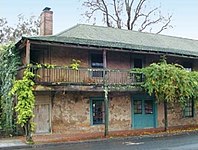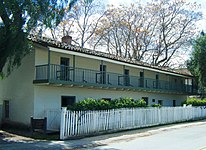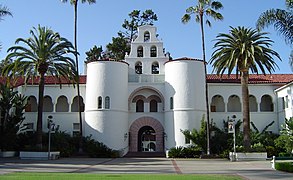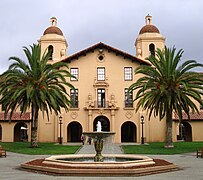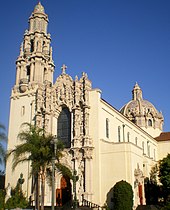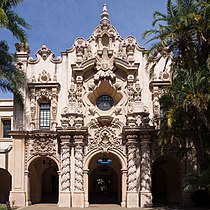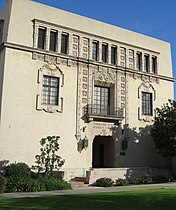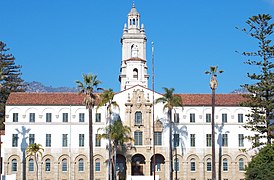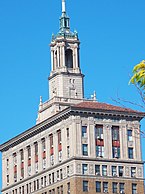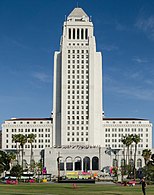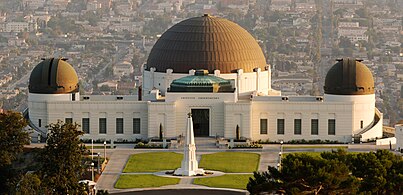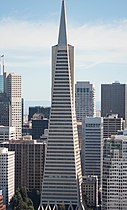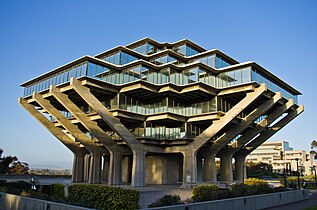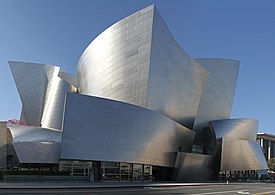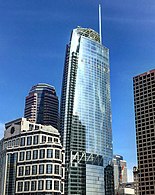User:Cristiano Tomás/Sandbox 3
The architecture of California reflects the diverse
Various
In the 20th century, California was heavily marked by the prominence of its own modernist styles, such as
History
Indigenous Californians
The historical building techniques and architectural styles of the indigenous peoples of the Californias, who have lived in California for over 19,000 years, varied by region, ethnic group, and time period. The subjugation of indigenous peoples in the Spanish missions of Caifornia largely stripped most indigenous communities of their traditional practices, including building practices. Within several generations of the large relocation of indigenous populations to Spanish missions, most indigenous building techniques were largely abandoned, with the integration of indigenous peoples into larger Californian society.
The
The Plains and Sierra Miwok traditionally built large rounded houses made of brush and mud, as well as umuucha, rounded bark huts.[2]
The Tongva of Southern California traditionally built willow houses, known as kiiy, which were located at the center of village sites, surrounded by accessory campsites and huts.[3]
- Examples of pre-colonial architecture of Indigenous Californians
-
A Gabrieleño Tongva willow house.
-
Tongva ceremonial house.
-
Maidu reed hut.
-
Chemehuevi adobe house.
Spanish colonial architecture
Through much of the Spanish period, the majority of California's cities and settlements lacked consistent masonry resources, meaning that the majority of construction was done using
Spanish colonial architecture is divided into three principal historic groupings: military architecture, civilian architecture, and the
The Spanish founded three pueblos, civilian towns that were not attached to a mission or a presidio:
While most religious architecture from this period concerns the Spanish missions in California, both pueblos and presidios always constructed church buildings to serve the soldiers and settlers. The only surviving presidio chapel now serves as Monterey's Cathedral of San Carlos Borromeo.[11] The only surviving pueblo church is Nuestra Señora la Reina de los Ángeles Church in Los Angeles.[12]
- Examples of the Spanish colonial architecture
-
La Purísima Mission
California Missions
The architecture of the
While the architecture of individual missions varies greatly, owing to time period and proximity to economic or population centers, all of the missions of
The impact that the California Missions have had on the architectural history of California is readily apparent in the many civic, commercial, religious, and residential structures built across the state in various times which exhibit the typifying features of the missions, especially red
- Examples of the California Missions
Mexican era architecture
In the period of
- Examples of the Mexican colonial architecture
Monterey Colonial
- Examples of the Monterey Colonial architecture
-
Old Monterey Customhouse
Mission Revival
- Examples of the Mission Revival architecture
California Churrigueresque
California Churrigueresque is a
The development of California Churrigueresque is intimately linked with the dissatisfaction Goodhue had with
Notable architects of the style include
- Examples of California Churrigueresque architecture
-
St. Vincent de Paul Church
-
Mission Dolores Basilica
Spanish Eclecticism
- Examples of the Spanish Eclectic architecture
-
Santa Barbara Courthouse
Beaux-Arts architecture
- Examples of Californian Beaux-Arts architecture
Art Deco architecture
- Examples of Californian Art Deco architecture
Modern architecture
- Examples of Californian Modernist architecture
Contemporary architecture
Contemporary architecture in California is highly diverse in form and styles. Various movements including Deconstructivism, Expressionist architecture, Sustainable architecture, high-tech architecture, and Neo-futurism have all been practiced to varying polarities in both northern and southern California.
- Examples of Contemporary Californian architecture
See also
References
- ^ "Cedar: Tree of Life to the Northwest Coast Indians," by Hilary Stewart describes and illustrates the harvesting of individual planks from living trees.
- ^ Craig D. Bates Museum Anthropology 17(2):13 (June 1993)
- ^ Chester King (1987). "Ethnohistoric Reconstruction of Subsistence-Settlement Systems in the Vicinity of Burton Mesa": 10. Retrieved 7 July 2019.
{{cite journal}}: Cite journal requires|journal=(help) - ^ hdl:1721.1/35331. Retrieved 16 May 2020.
- ^ "Casa de la Guerra". Office of Historic Preservation, California State Parks. Retrieved 2012-10-14.
- JSTOR 41171160. Retrieved 16 May 2020.
- JSTOR 41171160. Retrieved 16 May 2020.
- ^ Historical Society of Southern California; Pioneer Register, Los Angeles (1898). Annual Publication of the Historical Society of Southern California and Pioneer Register, Los Angeles (Public domain ed.). The Society. pp. 247–.
- Boulevards. Retrieved May 7, 2019.
- ^ "California Art Club". Traditional Fine Arts Organization, Inc. Archived from the original on 2008-05-15.
- ^ National Historic Landmark Summary by the National Park Service Archived October 8, 2012, at the Wayback Machine
- ^ Los Angeles Department of City Planning (September 7, 2007). "Historic - Cultural Monuments (HCM) Listing: City Declared Monuments" (PDF) (Document). City of Los Angeles.
{{cite document}}: Cite has empty unknown parameter:|edition=(help); Unknown parameter|accessdate=ignored (help) - ^ Newcomb, p. ix
- ^ Crump, p. 17
- ^ Baer, p. 50
- ^ "Historia del Arte y Arquitectura Mexicana" (PDF). Universidad Autónoma del Estado de Hidalgo. Retrieved 27 September 2019.
- ^ Christman (1985), p. 41
- ^ a b Montes, Gregory (Winter 1982). "Balboa Park, 1909–1911 The Rise and Fall of the Olmsted Plan". The Journal of San Diego History. 28 (1). Archived from the original on July 19, 2011.
- ^ "Cultural Resources of the City of San José" (PDF). City of San José. Retrieved 25 September 2019.
- ISBN 978-1586854324.
- ^ Marian Lestrange. "Church Architecture of Four Denominations in Los Angeles" (PDF). California State University, Northridge. Retrieved 27 September 2019.
- ^ David Gebhard. "The Spanish Colonial Revival in Southern California (1895-1930)" (PDF). University of California, Santa Barbara. Retrieved 27 September 2019.
- ^ Richard W. Amero. "The Making of the Panama-California Exposition, 1909-1915" (PDF). Journal of San Diego History. Retrieved 27 September 2019.
- ^ Richard W. Amero. "The California Building, A Case of Misunderstood Baroque" (PDF). Balboa Park. Retrieved 27 September 2019.
- ISBN 9789681620424.
- ^ "PCAD - San Francisco Unified School District (SFUSD), Mission High School #2, San Francisco, CA". pcad.lib.washington.edu. Retrieved 2018-10-25.
- ^ SF Planning Department
- ^ LA Curbed - Beverly Hills Landmarking 1932 Churrigueresque City Hall
- Bibliography
- Stewart, Hillary (1984). Cedar: Tree of Life to the Northwest Coast Indians. Seattle: University of Washington Press.
- ISBN 0-486-21740-X.
- Christman, Florence (1985). The Romance of Balboa Park (4th ed.). San Diego: San Diego Historical Society. ISBN 0-918740-03-7.
External links
Further Reading
- https://books.google.pt/books?id=rPcwuEe9MBQC&pg=PA382&lpg=PA382&dq=%22mexican+architecture%22+%22california%22&source=bl&ots=oiibd-1Sza&sig=ACfU3U2avGCtwSwoqL1jCqBoXAf2SiSNPQ&hl=en&sa=X&ved=2ahUKEwi6rbG02OrkAhVC5uAKHRzNCdUQ6AEwFHoECAkQAQ#v=onepage&q=%22mexican%20architecture%22%20%22california%22&f=false
- https://www.sandiegoreader.com/news/2000/may/25/cover-mexican-landscapes-san-diego/#
- https://www.latimes.com/entertainment/arts/miranda/la-et-cam-colonial-california-design-lacma-20180329-story.html
- https://scholar.google.com/scholar?start=20&q=%22californian+architecture%22&hl=en&as_sdt=0,5
- https://scholar.google.com/scholar?start=0&q=%22california%22+%22churrigueresque%22&hl=en&as_sdt=0,5
- http://calteches.library.caltech.edu/3982/1/Chemistry.pdf
- https://c100.org/books/articles/Gebhard_Spanish.Colonial.Arch.pdf
- https://books.google.pt/books?hl=en&lr=&id=gDSOF9-rsC4C&oi=fnd&pg=PR5&dq=%22architecture+of+california%22&ots=2IW4enOtL4&sig=x4M_dyVC_sUyeElmwfzMEr_vbII&redir_esc=y#v=onepage&q&f=false
- https://www.jstor.org/stable/25157399?seq=1#page_scan_tab_contents
- https://www.jstor.org/stable/25463690?seq=1#page_scan_tab_contents
- https://www.jstor.org/stable/25155953?seq=1#page_scan_tab_contents
- https://jsah.ucpress.edu/content/46/2/157.abstract
- https://jsah.ucpress.edu/content/46/2/157.abstract
- https://www.cambridge.org/core/journals/architectural-history/article/richard-neutras-search-for-the-southland-california-latin-america-and-spain/4F6845C41615F5EF98894912A7C48E36
- https://www.jstor.org/stable/41171275?seq=1#page_scan_tab_contents
- https://jsah.ucpress.edu/content/72/1/100.abstract
- https://books.google.pt/books?hl=en&lr=&id=WVw2AQAAQBAJ&oi=fnd&pg=PR13&dq=%22californian+architecture%22&ots=WAEmIEoDqU&sig=QyaJXixgRNhOeKR59h8bKWk3YUc&redir_esc=y#v=onepage&q&f=false
- http://csusm-dspace.calstate.edu/handle/10211.3/139189
[[Category:Architecture in California] [[Category:Culture of California] [[Category:Architecture of the United States]



